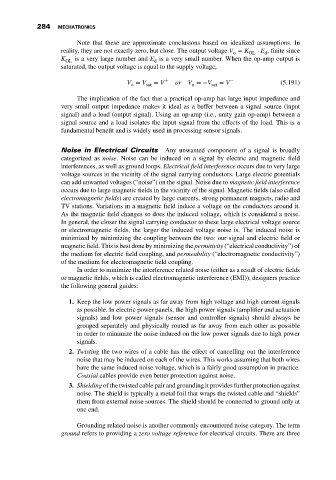Page 298 - Mechatronics with Experiments
P. 298
JWST499-Cetinkunt
JWST499-c05
284 MECHATRONICS Printer: Yet to Come October 28, 2014 11:15 254mm×178mm
Note that these are approximate conclusions based on idealized assumptions. In
reality, they are not exactly zero, but close. The output voltage V = K OL ⋅ E , finite since
d
o
K OL is a very large number and E is a very small number. When the op-amp output is
d
saturated, the output voltage is equal to the supply voltage,
V = V sat = V + or V =−V sat = V − (5.191)
o
o
The implication of the fact that a practical op-amp has large input impedance and
very small output impedance makes it ideal as a buffer between a signal source (input
signal) and a load (output signal). Using an op-amp (i.e., unity gain op-amp) between a
signal source and a load isolates the input signal from the effects of the load. This is a
fundamental benefit and is widely used in processing sensor signals.
Noise in Electrical Circuits Any unwanted component of a signal is broadly
categorized as noise. Noise can be induced on a signal by electric and magnetic field
interferences, as well as ground loops. Electrical field interference occurs due to very large
voltage sources in the vicinity of the signal carrying conductors. Large electric potentials
can add unwanted voltages (“noise”) on the signal. Noise due to magnetic field interference
occurs due to large magnetic fields in the vicinity of the signal. Magnetic fields (also called
electromagnetic fields) are created by large currents, strong permanent magnets, radio and
TV stations. Variations in a magnetic field induce a voltage on the conductors around it.
As the magnetic field changes so does the induced voltage, which is considered a noise.
In general, the closer the signal carrying conductor to these large electrical voltage source
or electromagnetic fields, the larger the induced voltage noise is. The induced noise is
minimized by minimizing the coupling between the two: our signal and electric field or
magnetic field. This is best done by minimizing the permitivity (“electrical conductivity”) of
the medium for electric field coupling, and permeability (“electromagnetic conductivity”)
of the medium for electromagnetic field coupling.
In order to minimize the interference related noise (either as a result of electric fields
or magnetic fields, which is called electromagnetic interference (EMI)), designers practice
the following general guides:
1. Keep the low power signals as far away from high voltage and high current signals
as possible. In electric power panels, the high power signals (amplifier and actuation
signals) and low power signals (sensor and controller signals) should always be
grouped separately and physically routed as far away from each other as possible
in order to minimize the noise induced on the low power signals due to high power
signals.
2. Twisting the two wires of a cable has the effect of cancelling out the interference
noise that may be induced on each of the wires. This works assuming that both wires
have the same induced noise voltage, which is a fairly good assumption in practice.
Coaxial cables provide even better protection against noise.
3. Shielding of the twisted cable pair and grounding it provides further protection against
noise. The shield is typically a metal foil that wraps the twisted cable and “shields”
them from external noise sources. The shield should be connected to ground only at
one end.
Grounding related noise is another commonly encountered noise category. The term
ground refers to providing a zero voltage reference for electrical circuits. There are three

